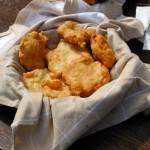First Nations Kids’ Perception of Food And Activity
 Yesterday, I presented a talk on the 5As of Obesity Management to home care nurses working with Alberta’s First Nations. It was clear from the discussions that cultural differences and barriers make addressing obesity particularly challenging in this setting.
Yesterday, I presented a talk on the 5As of Obesity Management to home care nurses working with Alberta’s First Nations. It was clear from the discussions that cultural differences and barriers make addressing obesity particularly challenging in this setting.
In this context, readers may appreciate an article by (CON Bootcamper) Ashlee-Ann Pigford and colleagues from the University of Alberta, just published in Qualitative Health Research, looking at how First Nations Children’s perceptions of food and activity may help inform a community-based obesity prevention strategies.
Fifteen 4th- and 5th-Grade students living in a rural Alberta Plains Cree First Nations reserve community participated in one of three focus group interviews that utilized drawing and pile-sorting activities.
Using an ecological lens to structure their findings, the analyses revealed that a variety of interdependent sociocultural factors influenced children’s perceptions.
Embedded within a cultural/traditional worldview, children indicated a preference for foods and activities from both contemporary Western and traditional cultures, highlighted family members as their main sources of health information, and described information gaps in their health education.
As the researchers note:
“A sense of pride and ownership of one’s culture were evident throughout. Children spoke about their First Nations cultural practices, preferred cultural foods, and activities, and considered many cultural foods and activities to be healthy. Children identified with their culture by referring to “us natives,” “we,” and “our culture,” which illustrated a shared understanding of what constituted their cultural identity. Cultural identification also resulted when children clarified what was included as part of their culture….It was common for children to suggest that traditional foods were important for identification purposes;“
Similarly,
“…children identified with traditional activities. For example, one participant explained that the reason children like to powwow dance (a variety of cultural dances performed at a gathering) is simply because “It’s part of our culture.”….Many cultural practices mentioned by the children required both traditional foods and activities to form a single event. Children’s descriptions conveyed fluidity between food and activity when they described traditional events; discussions of traditional food led to traditional activities, and vice versa.“
The role of family, both nuclear and extended, for food and activities was highly apparent:
“Children mentioned that traditional foods were consumed with family members, such as their kokums, mothers, and uncles, and that they learned to prepare traditional foods from family members. For example, one child mentioned, “Yesterday I helped my mom make bannock.” Participants spent a lot of time with family members when doing cultural activities. One child reported having participated in cultural dances with “my brothers and my cousin and my other cousin and my friend,” whereas another child stated that she danced with “my cousins,” and another with her “sister.” The statement, “My kokum and my dad and mostly everybody wants me to dance, and I have sports over the summer, and I help out my dad at my mushum’s [the Plains Cree word for grandfather] culture camp,” suggests that parents and extended family members supported children’s participation in cultural activities.“
The researchers also noted how the children’s health knowledge and beliefs were gained from older relatives:
“For example, when discussing Indian popcorn (a snack made of fried pork rinds and lard), one child stated, “It’s healthy, man. My uncle makes it all the time. He doesn’t get diabetes”; another said, “My dad had a heart attack from eating too much unhealthy foods.”“
It was also interesting to see how children determined what was healthy and what was not:
“Children recognized nature and the earth as important when assigning the labels healthy or unhealthy to a food or activity. When asked to describe healthy foods, they replied that food was healthy because of “the seeds,” or because “They’re from the ground,” or it “grows on a plant,” or simply, “’Cause it’s from nature.” Cultural dishes and animals were also seen as healthy, “’Cause [ceremonial dish] is from nature”; and “Because it’s animal, it’s part of nature.” Applying this logic, shrimp was described as healthy “Because it’s fish.” It was thought to be healthy because “it comes from the water,” and “because it never eats anything wrong or nothing, or never ate anything unhealthy in its time.” Children reported activities such as littering as unhealthy, “’Cause it wrecks the earth and it makes Mother Earth angry”; conversely, recycling was seen as healthy. The health of the planet was important to these children, and one child viewed paper as unhealthy “’cause it kills trees.” Because the environment and nature were valued, many sacred ceremonial practices associated with nature were considered to be healthy.“
“When children were asked to describe an unhealthy person, they referred to a variety of chronic conditions including obesity, heart attacks, diabetes, and dental caries. Children considered obesity to be an undesirable trait, and described an unhealthy person as “chubby” and “sloppy.” Heart health was addressed by the comments, “If you eat junk food you get a damaged heart. If you eat vegetables you won’t even get a damaged heart.” Participants discussed diabetes as a disease that develops from eating unhealthy foods, particularly “sweet stuff.” When asked about diabetes, one child commented that individuals with the disease might die or get cancer. Although responses varied, children agreed that diabetes was unhealthy. Additionally, some children considered poor dental health to be indicative of an unhealthy person.“
As the authors note:
“It is interesting that participants did not highlight teachers and school administrators as primary sources of health information, which suggests that children tended to rely on adult family members and experiential learning to form their understandings about health.“
Thus, it is easy to see why the authors would conclude that:
“Parents, extended family members, and elders must play prominent roles in future initiatives to prevent childhood obesity in this community.“
While it is important to recognise the influence of specific culture and beliefs of Aboriginal communities on kids’ health behaviours, as I pointed out in my talk, culture and beliefs are important determinants of health behaviours in all communities – far more so than perhaps most of us think.
Ignoring or denying such cultural contexts and beliefs is simply not a viable strategy to changing health behaviours in any community.
AMS
Edmonton, Alberta
![]() Pigford AA, Willows ND, Holt NL, Newton AS, & Ball GD (2012). Using First Nations Children’s Perceptions of Food and Activity to Inform an Obesity Prevention Strategy. Qualitative health research, 22 (7), 986-96 PMID: 22645224
Pigford AA, Willows ND, Holt NL, Newton AS, & Ball GD (2012). Using First Nations Children’s Perceptions of Food and Activity to Inform an Obesity Prevention Strategy. Qualitative health research, 22 (7), 986-96 PMID: 22645224
.
Aglukkaq Highlights Need For Culturally Appropriate Interventions
 Yesterday’s Summit on Healthy Weights brought together a wide range of stakeholders from all sectors to discuss community based responses towards improving health and wellness in Canada’s children and youth.
Yesterday’s Summit on Healthy Weights brought together a wide range of stakeholders from all sectors to discuss community based responses towards improving health and wellness in Canada’s children and youth.
In the discussion, I was particularly pleased to hear the Honourable Minister Leona Aglukkaq point out the importance of ensuring that community based interventions were culturally appropriate and community driven with a focus on improving health and wellness rather than simply reducing weights.
A particular challenge exists in Canada’s North, where communities are isolated with less availability of affordable healthy foods. Lifestyle transition has significantly reduced hunting and gathering of traditional foods, which provided these populations with nutritious and delicious diet.
As Gita Sharma, Endowed Chair in Aboriginal Health at the University of Alberta, a participant at this meeting pointed out,
“It is essential to work with Aboriginal communities to have community driven multi-institutional nutrition and physical activity intervention programs, that are evidence-based and evaluated. These programs must also provide training and capacity building for employment at the local level, so communities can implement these programs and ensure sustainability.”
Gita Sharma emphasized the benefits of partnerships with the food retail based companies, as people make decisions about food choices at the point of purchase, making this the natural target for community based nutrition interventions. In addition, findings from such research must be distributed to the communities, stakeholders, and to the endusers to guide policy.
Given the importance of culturally appropriate community and population-specific interventions, the Canadian Obesity Network will dedicate a full day to this issue at the 3rd National Obesity Summit, in Vancouver next year.
AMS
Edmonton, Alberta
Sharma Studies Nutrition From the Arctic to the Amazon
Last week I attended Medical Grand Rounds at the University of Alberta Hospital presented by our Faculty’s latest recruit Sangita Sharma (no relation), Professor in Aboriginal and Global Health and newly Endowed Chair in Aboriginal Health.
Sangita, who earned her PhD in nutritional epidemiology from the University of Manchester, UK, comes to Edmonton from the Nutrition Research Institute at the University of North Carolina at Chapel Hill. Prior to that, she was an associate professor at the University of Hawaii.
Her work focuses on the relationship between diet and disease in ethnic groups across the globe, including nutrient-gene interactions and the risk of cancer and heart disease.
Sangita spent nearly 10 years evaluating the diets of various ethnic groups in the US and through her research and recommendations, the USDA Pyramid Servings Database now includes food eaten by ethnic minority populations in the U.S. During this time she has conducted research in over 20 indigenous populations around the world.
Her current research focuses on Aboriginal health, nutritional and physical activity interventions to prevent chronic disease and improve dietary adequacies for Inuit/Inuvialuit populations in the Canadian Arctic, First Nations, Alaskan natives, Apache, Navajo and African-Americans, and monitoring the nutrition transition.
In her talk she presented a brief overview of her ongoing work in Canada’s Arctic, including Healthy Foods North, a culturally appropriate and community-based program to promote healthy eating and lifestyle amongst the Inuit and Inuvialuit population of Cambridge Bay and Taloyoak, NU and Inuvik and Tuktoyaktuk, NWT.
As Sangita pointed out, over 90% of the older population is presently medically obese and virtually 100% of the population does not meet the current recommendations for fibre, calcium, Vit A, D, E intake.
“Educating on healthy eating can be particularly challenging when the local language does not even have words for fibre, vitamins or minerals”, she notes.
By promote traditional food and activities, Sangita hopes to help improve people’s diet and activity levels thereby substantially reducing their risk of obesity and other diseases.
I was particularly impressed by the lengths Sangita goes to to ensure community engagement and ownership. Her strategy, described in a recent paper published in the American Journal of Health Behaviors, is certainly a strategy that can only be a model for interventions in any population.
With only a few community workshops, she demonstrated a huge impact on nutrition knowledge and behaviours, which will hopefully withstand the duration of the intervention.
In her presentation, Sangita also briefly touched on other ongoing projects including an intervention trial targeting salt intake in Barbados and a comparative study of the relationship between meat and the risk for colorectal cancer amongst the Japanese populations of Brazil, Hawaii and Japan.
On a personal note, I very much look forward to learning from and collaborating with Sangita on issues related to nutrition in another marginalized and understudied population – those living with severe obesity in Alberta and elsewhere.
AMS
Edmonton, Alberta
You can now also follow me and post your comments on Facebook
Gittelsohn J, Roache C, Kratzmann M, Reid R, Ogina J, & Sharma S (2010). Participatory research for chronic disease prevention in Inuit communities. American journal of health behavior, 34 (4), 453-64 PMID: 20218757
Meyo Pematchihiwin (Healthy Living Project)
Yesterday, Ashlee-Ann Pigford, currently completing her MSc under Noreen Willows and Geoff Ball here in the University of Alberta Department of Agriculture, Food and Nutritional Sciences, presented at the Alberta Diabetes Institute’s Research in Progress seminar series on her work in First Nations children.
Ashlee spent a Summer working in the Canadian Obesity Network office, so I was particularly interested in seeing her present.
The goal of her project was to perform both a quantitative and qualitative analysis of overweight and obesity amongst First Nation children living in an on-reserve Cree community in Alberta.
The qualitative part of her study included exploring the children’s traditional knowledge, preceptions about health, food and activity and to better understand their food and activity preferences.
The quantitative study included 105 First Nations children (Kindergarten to grade 6) and showed that almost half the children were overweight and almost one in five were obese. Around one in two had abdominal obesity, almost 65% were inactive (as assessed by pedometers) with only 36% meeting daily step recommendations.
In the qualitative study, which included having kids drawing pictures and sorting them into healthy and unhealthy piles, it became evident that the children had a strong identification with their traditional cultures and values. There was a great importance of both traditional foods and their role at cultural events as well as on hunting.
The children often cited their mothers or grandmothers as their source of health information and gained their beliefs from older relatives.
They clearly associated obesity, heart disease and diabetes to being unhealthy and considered natural foods and many sacred ceremonial practices associated with nature as healthy.
As Ashlee summarized, her findings clearly show the importance of community specific context of their health beliefs and choices, which emphasises the need for multilevel ecological approaches to tackling excess weight that need to be designed in a culturally relevant manner to promote healthy lifestyles.
It was also evident that it is crucial to involve the elders, extended family members and the parents in any meaningful initiatives to address childhood obesity in this (and probably other) First Nations community.
Congratulations Ashlee on completing your study and this most insightful presentation!
AMS
Edmonton, Alberta
When Apple is a Bad Word
 This weekend I experienced my first trip to the Yukon, where I attended the 2008 Conference of the Canadian Association of Occupational Therapists (CAOT) in Whitehorse.
This weekend I experienced my first trip to the Yukon, where I attended the 2008 Conference of the Canadian Association of Occupational Therapists (CAOT) in Whitehorse.
CAOT is a partner of the Canadian Obesity Network and I believe that this was the first time that a CAOT conference featured a professional issue forum on Obesity and Healthy Occupation. Speakers in this session, chaired by Mary Forhan (McMaster), included Kim Raine (U Alberta), Gaye Hanson (Hanson & Associates) and myself.
While Kim talked about how obesity has to be seen in the context of societal changes and pressures and I presented the medical perspective on obesity as a chronic disease, Mary talked about the role and opportunities for occupational therapists in obesity prevention, treatment and in allowing patients with obesity to live complete and dignified lives (no matter how good our prevention or treatments, there will always be obese individuals in our society). Gaye, a former Midwife and ex-Deputy Minister of Health and Social Services in the Yukon, herself of Cree Ancestry, presented a most enlightening view of the challenges of addressing obesity in Aboriginal populations.
But for me the most moving insights came from the closing remarks by Madeleine Dion Stout (picture), who was also the keynote speaker at the conference. Born and raised on the Kehewin First Nation in Alberta and nursing graduate from the Edmonton General Hospital, Madeleine worked for many years in the Medical Services Branch of Health Canada and has been a member of dozens of First Nations health committees and task forces aimed at improving the health of First Nations, Inuit and Metis.
The one sentence that I found particularly enlightening was (in the context of obesity – “apple and pears”) “don’t ever refer to an Indian as an apple!”. For an Indian, an apple implies being “red” on the outside but “white” on the inside – not a very polite thing to say! All goes to show how cultural context can fully change the meaning of even the most seemingly innocuous words.
Most interestingly, Madeleine, herself a “victim” of residential schools made the same connection between the pain, suffering, broken spirit and shame inflicted by residential schools and the increased risk for obesity that I had made in my blog posting a day earlier. Imagine my surprise, as Madeleine of course was unaware of my take on the “apology”.
Overall a most insightful weekend – much to think about.
Thank you CAOT for inviting me to Whitehorse.
AMS
Edmonton, Alberta




